Saturday, August 9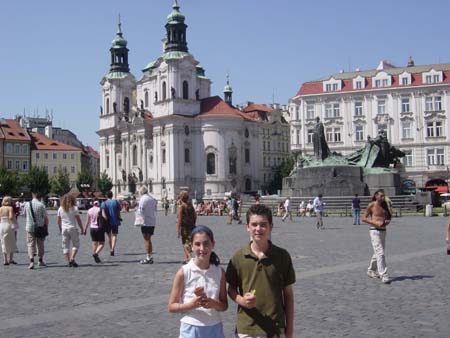
Paula: We spent the afternoon today exploring Prague with an enthusiastic private guide. We had hired the guide with a request to learn more about the history of the city, including the recent history of the Nazi and Communist regimes. Our guide was very resourceful and more than happy to share with us about his country and personal experiences. This was particularly fascinating because he was a student in 1989 and assisted in the Velvet Revolution.
Some of the highlights of our 4-hour walking tour included the following:
" We learned about Prague's architecture and saw many examples of Gothic (early, mid and late), Renaissance, Baroque, Classical, Art Nouveau (from 1910-1920), Cubism, and Fundamentalist (in 1930s) styles. Prague is considered more progressive then the West when it comes to architecture. We still aren't always to identify the architecture we are seeing, but we know today that we saw it all!
" We saw at least 20 churches (maybe even more) and can attest to the
caption, "Prague, the city of a hundred tall spires." Several of
these churches were built in the 1300s and we saw the oldest synagogue in
Europe (built in 1250 and still in use today). There are as many gothic churches
here (120) as in Paris. 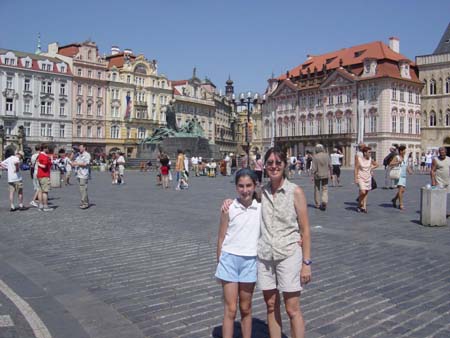
" We toured the old Jewish ghetto where there are 4 old synagogues, a very old cemetery (including tombstones from the 13th century) and learned about the history of Jews living in Prague. The Jews were welcome and religious freedom and diversity were tolerated early in Prague's history (there were 12 different religious organizations in Prague in the 1400s) until the Habsburg Dynasty abolished the Jewish ghetto in 1781. Then later, during the first republic (early 1900's), Jews were encouraged to come to Prague for their intellectual ideas during Prague's "Golden Age." The Nazis put an end to the Golden Age and took the lives of more then 7,000 Jews in Prague (365,000 in Czechoslovakia). Today there are only about 6,000 Jews in the Czech Republic.
" We also learned that Prague is the location of important religious
history. Religious freedom and the Protestant theology were promoted here
even before Martin Luther - Jan Huss (1371-1415) started the reformation in
Prague and was burnt at the stake for his belief that the Bible and not the
Pope was the primary source on Christianity. A magnificent statue dedicated
to his life is prominent in the Old Town Square. The Habsburg Dynasty marked
an end to such tolerance and executed or drove away 30-50% of the Protestants.
Today, while there are more Catholics then Protestants, over 60% of the population
are not affiliated with any religion. 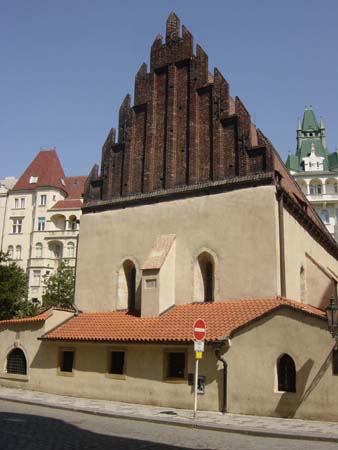
" We saw Charles University, the oldest university in Central Europe, established in 1348.
" It was interesting to learn that being "thrown out the window" has literal and political importance here in Prague where there were at least 4 specific significant incidents of people being thrown out of windows.
" Our guide spoke passionately about the Communist rule and Velvet Revolution.
We stood in the street where student demonstrators were brutally injured during
the uprising in 1989, and in Wenceslas Square where 750,000 people (60% of
the population) demonstrated and forced the peaceful resignation of the Communist
government. Our guide spoke of helping in the Revolution and how students
were able to get the factory workers and local citizens to support their cause,
enabling the Communist government to be overthrown with little violence. He
spoke of how life is different now, describing his life before as "It
was more likely that I would spend time in prison than being able to travel
abroad." He described how people were punished if they did not 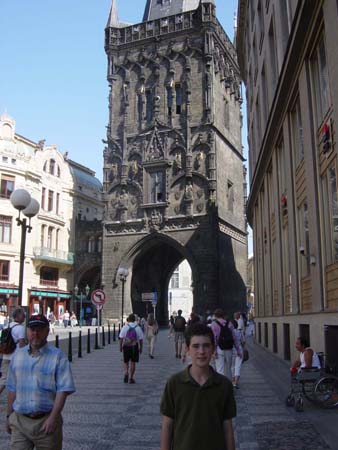 actively
support the Communist Party-sent to labor camps and expelled from school.
Often children were punished for their parent's actions, not being allowed
to study. He said the number of students in his country were half what it
was in other countries and how the Communists had devastated their intellectual
resources. He described smuggling books from foreign embassies and how the
people learned how to deceive the Communists. He stated that salaries in Western
Europe were 20 times higher than in Czechoslovakia, but thankfully now are
only 4 times higher. He was clearly thankful for his freedom and stated that
while some older people talk about "the good old days", he does
not believe any would be willing to give up their freedom. He believes while
many people do not have more material possessions then in the past, that they
now at least have more choices. He seemed extremely proud of this country's
rich heritage and very upbeat about its future. He showed us where the monument
to Stalin has been replaced with a pendulum to remind the country of how times
change.
actively
support the Communist Party-sent to labor camps and expelled from school.
Often children were punished for their parent's actions, not being allowed
to study. He said the number of students in his country were half what it
was in other countries and how the Communists had devastated their intellectual
resources. He described smuggling books from foreign embassies and how the
people learned how to deceive the Communists. He stated that salaries in Western
Europe were 20 times higher than in Czechoslovakia, but thankfully now are
only 4 times higher. He was clearly thankful for his freedom and stated that
while some older people talk about "the good old days", he does
not believe any would be willing to give up their freedom. He believes while
many people do not have more material possessions then in the past, that they
now at least have more choices. He seemed extremely proud of this country's
rich heritage and very upbeat about its future. He showed us where the monument
to Stalin has been replaced with a pendulum to remind the country of how times
change.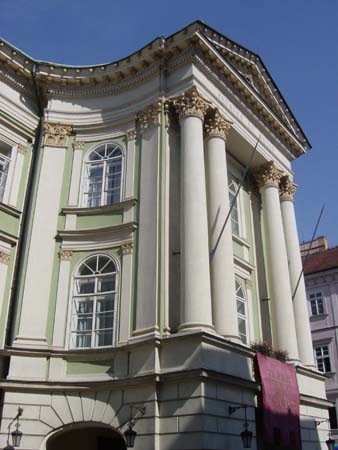
" We also asked him about how the city has changed since 1989. He noted the increase in commercialism-that there were few shops and private businesses before-buildings had scaffolding to protect pedestrians from crumbing facades-the economy was focused on military build-up. He noted the importance of tourism in the country's economic recovery.
" Regarding daily life, he noted that education (even at the University) is free. Diversity is limited-there are gypsies, Russians, Chinese and Vietnamese but no Africans. Ice hockey and tennis are the most popular sports. A mole called Krtek is an extremely popular cartoon character that was developed here and is becoming popular in other countries as well. Beer, glass and shoes are major exports, and Czechs drink on average 160 liters of beer a year.
I was most impressed with our guide's optimism and admiration for his country's
innovative and progressive culture. As he noted, in 1918 they became the first
democracy in Eastern Europe and one of the most industrialized. He described
how the Nazi and Communist eras have slowed down their "flourishing"
growth, but that now they have a chance to catch up with the West or as he
said the "English speaking world." 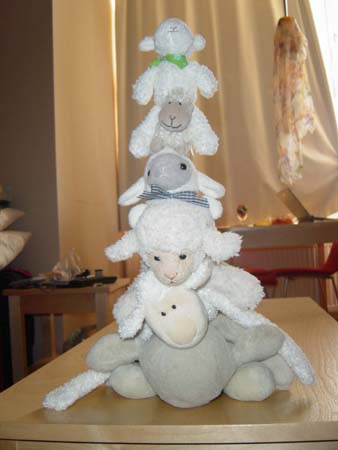
We also spent time today locating the Czech Airlines office and purchased our tickets to St. Petersburg, and began making inquires for hotels there. David and Katie added to their collections-David has been collecting key chains from each country and Katie has been purchasing a sheep (stuffed animal). Each sheep also has to be given an appropriate name. For example today's sheep was promptly christened "Ceska" which is what people are called from the Czech Republic. We also watched the Gothic astronomical clock in the Old Town Hall which has moving statues on the hour. The clock shows the date and time and was made in the early 1400s.
We learned a lot today but hope to take in some parks and "green space" tomorrow.
Distance Walked: 5.00 miles (estimated… our pedometer isn't working!!!)
David: Throughout the past month we have come to appreciate the simple
luxuries that are common in America (and when we're not traveling...). For
the last six weeks we have had to cope with difficulties, such as long hot
walks, hotels that are hot and have limited space, mysterious food and water,
communicating with others who speak little or no English, and constantly moving
from country to country. We have come up with a list of special treats that
help us during our travels.
Some of our special treats include…
" Cold drinks on a hot day
" Taxi rides (instead of always having to walk…)
" Air conditioning
" Open benches in the shade
" Separate beds and space (for Katie and me)
" Sleeping in
" English speaking people (fluent English)
" Home made Pasta
" Ice cream
" Clean public bathrooms, with toilet paper
" Privacy
" Internet access
" American burgers and fries
" English menus
" Naps in the afternoon
" E-mails from home
" Light-weight backpacks
" Laundromats (conveniently located)
" Accurate maps
" Courteous drivers
" Still water (with no gas!)
" Fresh fruit and vegetables
" Roomy hotels
" Kitchens (with a stove) in our hotel room
" English newspapers and television channels
" Multiple bathrooms in our hotel rooms
" Easy transportation (not connecting with other trains or buses)
" Parks
" Hotels in quiet and convenient areas
" Countries that use the Euro
" Spending at least one week at the same place
" Comfortable beds
" Down time
" Showers with curtains
" Extra sheets and pillows
With just about one third of the first trip completed, I am feeling great. I thought for sure that I would feel exhausted and overwhelmed at this point, but to my surprise I'm not. It's very hard to believe that we only left six weeks ago. I feel like I haven't been home for ages. Although I am excited about getting home, I am really enjoying traveling and learning as much as I am. It feels great to look back at how much we've accomplished in such little time. I am also excited about seeing new and different places. The first shock to us was in Prague. It was really different than anything we have ever seen before. I like getting to a place for the first time and realizing how different it is from the States. It's great when you get to a new city and it turns out to be like nothing like you had expected.
